Wildlife sanctuaries in Gujarat are a mosaic of life, offering an immersive experience into rich biodiversity. From the roaring Asiatic lions of Gir to the graceful blackbucks of Velavadar, these ecosystems are havens for threatened species and nature lovers alike. Gujarat, a paradise for wildlife enthusiasts, boasts an impressive array of national parks and wildlife sanctuaries in Gujarat.
Visitors can witness the grandeur of Asiatic lions at Gir Forest, marvel at the flamingos at Nalsarovar, or spot the elusive wild ass in its natural habitat. Each wildlife sanctuary in Gujarat offers a unique experience, providing opportunities to see diverse species amidst breathtaking landscapes. Our guide to wildlife sanctuaries in Gujarat highlights top destinations, complete with wildlife insights and travel tips. Explore Gujarat’s wild side and create unforgettable memories in nature’s masterpieces.
| Sanctuary/Reserve | Location | Major Wildlife Supported |
| Wild Ass Sanctuary | Little Rann of Kutch | Indian Wild Ass, Nilgai, Blackbuck |
| Nal Sarovar Birds Sanctuary | Ahmedabad District | Various Migratory Birds, Flamingos |
| Jessore Sloth Bear Sanctuary | Banaskantha District | Sloth Bear, Leopard, Wild Boar |
| Barda Wildlife Sanctuary | Porbandar District | Asiatic Lion, Leopard, Indian Wolf |
| Hingolgadh Nature Education Sanctuary | Jasdan, Rajkot District | Indian Leopard, Sloth Bear, Hyena |
| Narayan Sarovar Sanctuary | Kutch District | Chinkara, Desert Fox, Indian Wolf |
| Khijadia Bird Sanctuary | Jamnagar District | Avian Species, Waterbirds |
| Ratanmahal Sloth Bear Sanctuary | Dahod District | Sloth Bear, Panther, Indian Civet |
| Kutch Desert Sanctuary | Kutch District | Wild Ass, Desert Fox, Indian Fox |
| Gaga Wildlife Sanctuary | Jamnagar District | Nilgai, Chinkara, Indian Fox |
| Rampara Wildlife Sanctuary | Rajkot District | Panther, Blue Bull, Wild Boar |
| Thol Wildlife Sanctuary | Ahmedabad District | Flamingos, Sarus Crane, Blackbuck |
| Shoolpaneshwar Wildlife Sanctuary | Narmada District | Bengal Tiger, Indian Giant Squirrel |
| Porbandar Birds Sanctuary | Porbandar District | Seabirds, Waders, Shorebirds |
| Pania Wildlife Sanctuary | Morbi District | Indian Gazelle, Blue Bull, Hyena |
| Balaram Ambaji Wildlife Sanctuary | Banaskantha District | Leopard, Sloth Bear, Indian Wolf |
| Jambughoda Wildlife Sanctuary | Panchmahal District | Leopard, Four-Horned Antelope, Sloth Bear |
| Purna Wildlife Sanctuary | Dang District | Indian Pangolin, Jungle Cat, Barking Deer |
| Kutch Bustard Sanctuary | Kutch District | Great Indian Bustard, Houbara Bustard |
| Chhari Dhand Conservation Reserve | Kutch District | Indian Wild Ass, Blackbuck, Nilgai |
| Kachchh Biosphere Reserve | Kutch District | Indian Wild Ass, Desert Fox, Indian Wolf |
Exploring Gujarat’s Natural Marvels: 21 Wildlife Sanctuaries in Gujarat
1. Wild Ass Sanctuary

The Wild Ass Sanctuary, one of the largest sanctuary areas in Gujarat, spans over 5,000 sq. km. It provides a rare glimpse into the lives of the endangered Indian Wild Ass and other wildlife marvels. The landscape, characterized by arid salt marshes, is home to desert foxes, migratory birds, and numerous other animals. The wildlife ministry in Gujarat tirelessly works to maintain and preserve the natural habitats and the vast diversity they support. In this haven for biodiversity, not only do desert foxes and migratory birds find a resilient sanctuary, but it also reinforces the importance of including these best sanctuaries in your travel plans.
- Location: Little Rann of Kutch
- Famous For: Indian Wild Ass and diverse wildlife including desert foxes and migratory birds
- Recommended Visit Time: The best time to visit is from October to March, aligning with the guidance for the optimum sanctuary exploration experience.
2. Nal Sarovar Birds Sanctuary
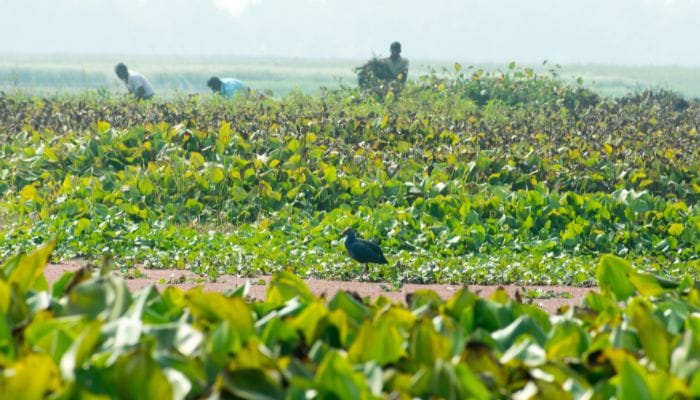
Nal Sarovar Bird Sanctuary, established in 1969, is a haven for nearly 250 species of birds, including the majestic Brahminy Duck and vibrant Kingfishers. It is the largest wetland bird sanctuary in Gujarat, attracting a myriad of migratory birds during the winter months. Drift along its tranquil water bodies with a local guide by your side, and with a trusty pair of binoculars, you’re sure to catch unforgettable sights and symphonies of bird calls, including the harmonious concert of wetland specialists.
- Location: Bagodara Nalsarovar Link Rd, Nalsarovar, Gujarat
- Famous For: Migratory and native bird species, including a diverse population of wetland birds like geese, ducks, and cormorants.
- Recommended Visit Time: Dawn or early morning for the best bird activity and to experience the sanctuary’s peaceful ambiance as the wetland bird sanctuary comes to life.
3. Jessore Sloth Bear Sanctuary

Covering 180 sq km, Jessore Sloth Bear Sanctuary is a secure home for sloth bears and other wildlife such as leopards, Indian civet cats, and numerous bird species. It also offers striking vistas of Jessore hill, the second-highest peak in Gujarat. Exploring this wildlife sanctuary in Gujarat not only assures encounters with these nocturnal bears but also offers striking vistas of the second-highest peak in Gujarat, Jessore hill, and deep insights into the fragile ecosystem it sustains.
- Location: Near Palanpur in Banaskantha district, Gujarat
- Famous For: Sloth bears and diverse fauna
- Recommended Visit Time: August to October when the landscape is lush and rivers are full
4. Barda Wildlife Sanctuary
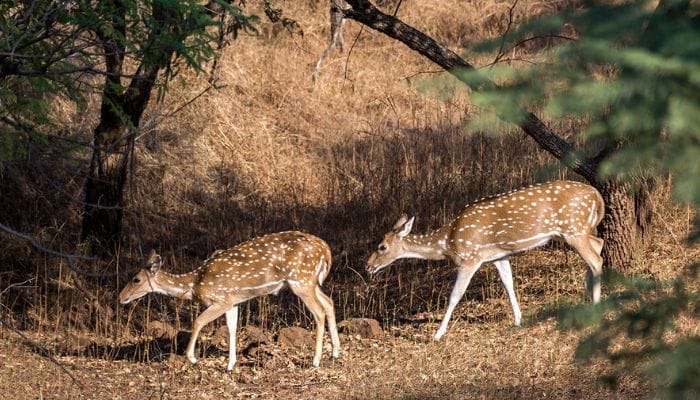 Image Source
Image SourceAs you venture into the Barda Wildlife Sanctuary, you’re greeted by a tapestry of verdant landscapes and undulated terrains that were once the private forests of princely states. Today, Barda stands as a vital conservatory, nurturing populations of endangered species such as leopards and hyenas along with a host of reptiles like the three most venomous snake species in India. The sanctuary, also home to a variety of species like jam barda, crocodiles, and the elusive barking deer, contributes enormously to the region’s biodiversity. For those planning a visit, the best time to visit Barda Hills Wildlife Sanctuary is November to Mid June, ensuring you capture the essence of its magnificence.
Ornithologists and bird lovers can indulge in the sight of crested eagles or perhaps witness the rare chausingha amidst a flamboyance of migratory flamingos during the season. With over 650 plant species, Barda, near Junagadh in Gujarat, is a biodiversity hotspot that beckons every nature lover, from trekkers navigating its hilly pathways to photographers capturing its picturesque creeks.
- Location: 15 km from Porbandar, Gujarat
- Famous For: Wide array of fauna especially leopards, diverse flora, and historically being part of the Ranavav and Jamnagar princely states
- Recommended Visit Time: October to February for pleasant weather and optimal wildlife spotting opportunities, offering a chance to see sambar in their natural habitat, though the sanctuary welcomes visitors until mid-June for those wishing to explore later in the season.
5. Hingolgadh Nature Education Sanctuary
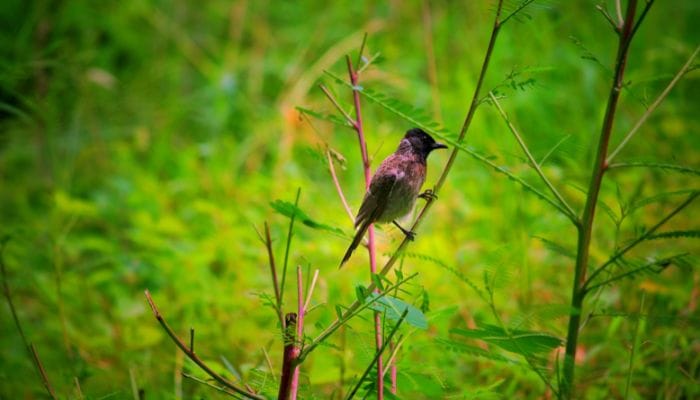
Step into the compact yet vibrant world of Hingolgadh Nature Education Sanctuary, a hub of learning and wildlife observation near Rajkot. With its unique rocky terrain and a medley of thorny vegetative patches, Hingolgadh provides a sanctuary for an interesting blend of fauna, including the graceful chital and robust nilgai. The sanctuary is a favorite for those on a sightseeing tour, offering a refuge for majestic creatures such as chinkaras and blue bulls, also known as nilgai – an exhilarating sight for wildlife enthusiasts. One can almost envisage the nimble kutch chinkara bounding across the landscape, embodying the wild spirit of Gujarat.
It also becomes a scenic hotspot for birdwatchers, as migratory and resident birds fill its skies with color and song, adding to the experience of any animal sanctuary visit. Ideal for educational trips, this sanctuary not only focuses on preservation but also on imparting knowledge about the importance and interdependence of flora and fauna, which is vital to the ecosystem of the nearby Dang district and throughout Gujarat.
- Location: Near Jasdan in Rajkot district, Gujarat
- Famous For: Chinkaras, blue bulls, and bird education programs
- Recommended Visit Time: Post-monsoon for lush landscapes and teeming wildlife activity
6. Narayan Sarovar Sanctuary
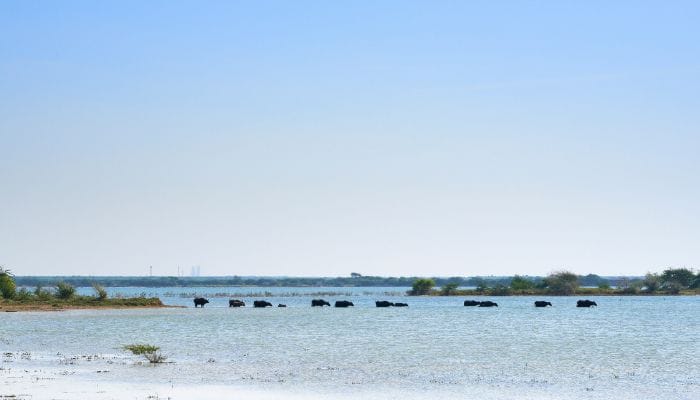
Narayan Sarovar Sanctuary, located in the arid expanse of Kutch, harbors a fascinating ecosystem animated by its 15 species of endangered wildlife. The sanctuary’s rich biodiversity includes the ornate sambar deer and the swift-footed chital, enhancing its allure for nature enthusiasts on a sightseeing tour. The ability of these species to adapt to the sanctuary’s harsh climactic conditions makes Narayan Sarovar an intriguing site for wildlife observation. Additionally, the graceful Kutch chinkara, known for its agility and elegance, is a sight to behold amidst the rugged wilderness.
The sanctuary also serves as a vital refuge for the rare Indian Bustard, further solidifying its status as a haven for diverse species. Apart from its wildlife riches, visitors can explore an array of historical and spiritual sites within the sanctuary, including the revered Narayan Sarovar Temple.
- Location: Lakhpat in Kutch district, Gujarat
- Famous For: Rare and endangered species, cultural and religious sites including the sambar deer, chital, and the indigenous Kutch chinkara.
- Recommended Visit Time: Between September and February for cooler weather and optimal wildlife viewing.
7. Khijadia Bird Sanctuary
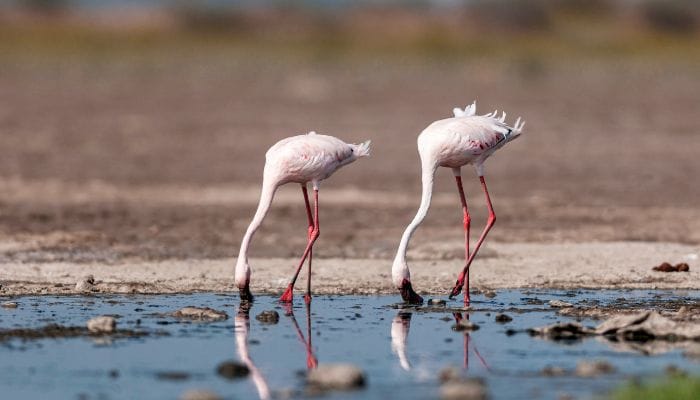
Khijadia Bird Sanctuary, a renowned wetland bird sanctuary in Gujarat, awaits with an ornithological banquet that tantalizes the eyes and ears. This serene sanctuary, located just 16 km from Jamnagar Railway Station, melds salt and freshwater bodies, creating diverse habitats that play host to over 250 species of birds. Here, rare sightings of Dalmatian pelicans and Indian skimmers charm visitors, establishing Khijadiya as a significant bird sanctuary for both spectatorship and conservation efforts.
The man-made wetlands demonstrate a symphony of conservation and human ingenuity, inviting anyone seeking tranquility or a chance to admire nature’s splendor through birdwatching. Additionally, the beautiful aquatic life which includes jellyfish and the pearl oyster, adds an underwater dimension to the sanctuary’s diversity.
- Location: Near Khijadiya Village in Jamnagar, Gujarat
- Famous For: An assortment of both resident and migratory birds, man-made wetlands, including its status as a vital wetland bird sanctuary, and a sanctuary for underwater creatures like the pearl oyster and jellyfish.
- Recommended Visit Time: Early mornings or late afternoons when birds are most active
8. Ratanmahal Sloth Bear Sanctuary
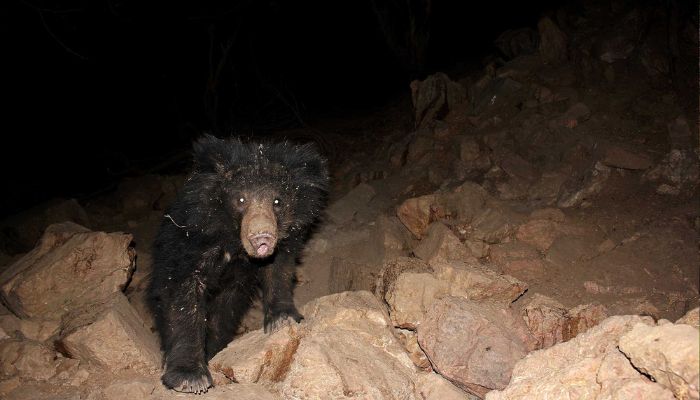 Image Source
Image SourceAt the Ratanmahal Sloth Bear Sanctuary, visitors can witness the elusive and endangered sloth bears thrive in their natural habitat. Nested in the hilly terrain of Gujarat’s Dahod district, this refuge also harbors species such as the intriguing striped hyena and the sambar deer, prominent residents of the region’s forests. Spanning approximately 55 sq km, the sanctuary is dedicated to protecting these unique creatures, as well as the endangered sloth bears. In addition to sloth bears, the sanctuary serves as a safe haven for an array of other wildlife, such as leopards, four-horned antelope, the Bhavnagar blackbuck and a plethora of bird species, offering a bucolic escape to the keen-eyed wildlife spotter.
The best time to visit is during the cooler months of October through February when the climate is most conducive for the observation of wildlife, including the extensive variety found in Bhavnagar. Close encounters with the sanctuary’s diverse residents, from the majestic sambar to the stealthy hyena, against the enchanting hilly backdrop make for a memorable adventure for all wildlife lovers.
- Location: Dahod district, Central Gujarat
- Famous For: Sloth bears, leopard sightings, rich biodiversity, and now gaining recognition for the presence of sambar deer and striped hyena.
- Recommended Visit Time: October to February for the most comfortable and rewarding sightseeing experience
9. Kutch Desert Sanctuary
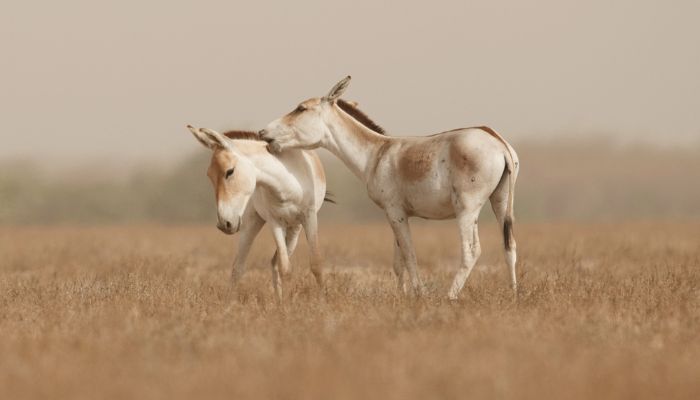
Kutch Desert Wildlife Sanctuary is an unforgettable excursion into one of India’s most enthralling wildernesses. Bordering the enigmatic districts of Gujarat and the absorbing cultural tapestry of Rajasthan, the Kutch Desert Wildlife Sanctuary stands as a testament to the region’s natural splendor. Situated in the Great Rann of Kutch, not only does the sanctuary share its ecological richness with the nearby Gulf of Kutch, known for its diverse marine life including the elusive dugong and vibrant Gulf of Kutch sponges, it’s also within the regional proximity of the Vansda National Park – a hidden jewel within Gujarat’s Navsari district.
Vansda is a treasure trove of biodiversity, home to the evasive pangolin and the stately nilgai, enhancing South Gujarat’s reputation as a sanctuary for a variety of majestic and unique wildlife.
- Location: Great Rann of Kutch, Gujarat
- Famous For: Great Indian Bustard, flamingos, vast salt marshes, and bustling jungle safari opportunities
- Recommended Visit Time: November to February when the climate is milder and the sanctuary’s wildlife, including its marine biodiversity, is most vibrant
10. Gaga Wildlife Sanctuary

Gaga Wildlife Sanctuary emerges as a unique landscape where avid birdwatchers and nature enthusiasts find common ground. This sanctuary not only hosts an array of migratory birds but also is a site where the golden jackal makes its presence known, adding diversity to the ecosystem. Encompassing 332.87 hectares of pristine wilderness, the sanctuary transforms into a haven for avian life during winter, attracting flocks of migratory birds such as flamingoes, cranes, and pelicans. Moreover, it is imperative for the conservation of the vulnerable Houbara Bustard and the cryptic Indian Wolf.
Apart from avifauna, Gaga is a sanctuary where the gentle rustle of the jackal can occasionally be heard, as it navigates the underbrush. Visitors may also get lucky and spot a playful dolphin in the nearby waters, as these intelligent marine creatures are known to inhabit the region. With 12 mammal species amongst its inhabitants, including the elusive Indian Wolf and the adaptable jackals, Gaga offers an intimate encounter with the wild’s authenticity for those eager to observe or to bask in serenity.
- Location: Bhatia taluka, Jamnagar, Gujarat
- Famous For: Migratory birds, rare fauna like the Houbara Bustard, dolphin sightings, and the presence of opportunistic jackals.
- Recommended Visit Time: October to March, which is the peak time for avian migration and when the sanctuary’s flora and fauna are most vibrant
11. Rampara Wildlife Sanctuary
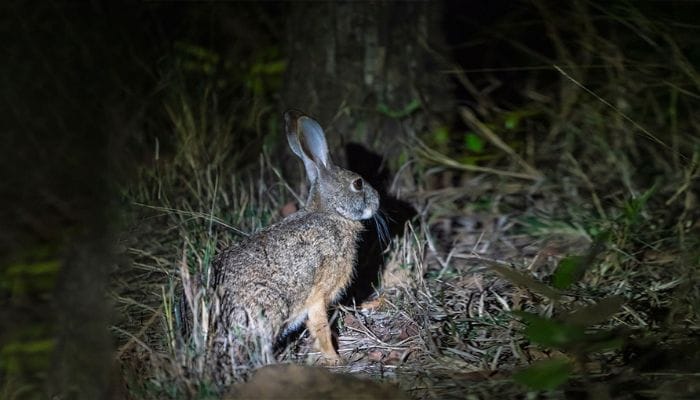 Image Source
Image SourceRampara Wildlife Sanctuary, a quaint corner of Gujarat’s Rajkot district, presents wildlife aficionados with a picturesque mosaic of woodlands and grasslands. Although small in stature at just 15 sq km, the sanctuary punches above its weight by hosting an extensive roster of fauna including over 20 species of mammals and nearly 130 species of birds. Animals such as Jungle Cats, Blue Bulls, and Hyenas roam its expanse, and observers may even glimpse the stealthy movements of Wolves. Home to several species of snakes, Rampara is a treasure trove for herpetologists, while its abundance of antelopes offers a chance to marvel at one of the largest antelope species in the country.
- Location: Near Wankaner, about 60 km from Rajkot district, Gujarat
- Famous For: Dense wildlife population and diversity despite its small size
- Recommended Visit Time: Mid-October to January for the best climate and wildlife spotting opportunities
12. Thol Wildlife Sanctuary

Thol Wildlife Sanctuary serves as a thriving hub for birdlife, nestled around the picturesque Thol Lake, which is a stone’s throw away from the bustling city of Ahmedabad. Renowned as a birdwatcher’s delight, the sanctuary is a prime spot for spotting diverse species such as rosy pelicans, lesser and greater flamingos, and especially the majestic brahminy ducks amidst the vibrant spectacle of local and migratory birds. Noteworthy for its pelicans, flamingos, and the elegant sarus cranes, it’s also where one can enjoy the grace of these avians against the calm waters and open skies.
While Thol may lack the mahuda trees typical of the reserves closer to Bhavnagar, the sanctuary’s grasslands and wetlands are a habitat for an array of waterfowl including ducks, which are a common yet enchanting sight. This forms a balanced ecosystem that’s crucial for the conservation of wildlife.
- Location: Mehsana district near Ahmedabad, Gujarat
- Famous For: Wide array of bird species particularly waterfowl like ducks, scenic beauty of the freshwater lake
- Recommended Visit Time: Early morning for the most active birdlife and the best light for photography
13. Shoolpaneshwar Wildlife Sanctuary
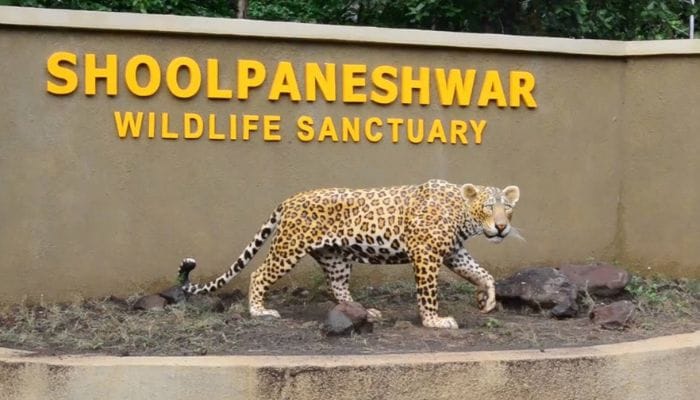 Image Source
Image SourceShoolpaneshwar Wildlife Sanctuary, nestled in the verdant landscape of the western Satpura Range, is a treasure for wildlife enthusiasts and eco-travelers. Spanning around 607.71 square kilometers, this sanctuary is flush with deep valleys, gushing waterfalls, and dense forests, making it a haven for numerous species. The protected area teems with biodiversity, including leopards, sloth bears, and various primates, while its avian population is a draw for birdwatchers. The sanctuary not only captivates with its wildlife but also charms visitors with its breathtaking natural beauty and serenity.
- Location: Near the Narmada River, Narmada District, Gujarat
- Famous For: Dense forests, diverse wildlife including the rare sloth bear, and picturesque landscapes
- Recommended Visit Time: November to March when the dense forest becomes lush and wildlife is plentiful
14. Porbandar Birds Sanctuary

Porbandar Bird Sanctuary distinguishes itself as a notable urban birding haven, tucked within the bustling city of Porbandar. This unique sanctuary, although compact at just about 1 square kilometer, offers a verdant oasis to a multitude of bird species. Its sweet water lake attracts avians like flamingos, pelicans, ibis, and spoonbills. Moreover, it becomes a temporary residence for migratory birds seeking reprieve during the winter. Bird enthusiasts flock here to indulge in the riot of colors and songs of these majestic creatures, making it an exceptional spot for ornithological studies and photography.
- Location: Porbandar City, Gujarat
- Famous For: Hosting an impressive number of bird species within city limits
- Recommended Visit Time: Winters, during the migratory season, for the chance to witness a wide variety of birds
15. Pania Wildlife Sanctuary
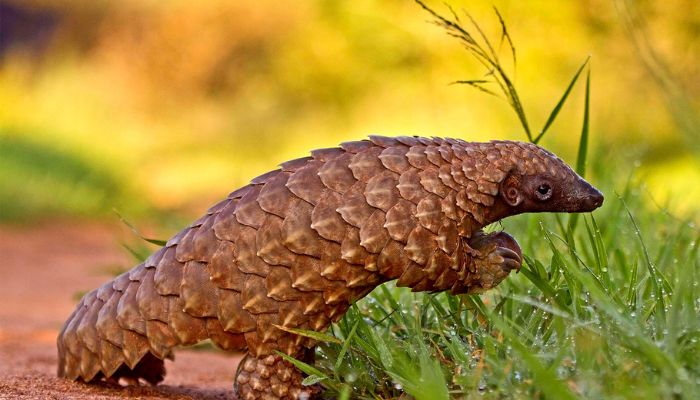 Image Source
Image SourcePania Wildlife Sanctuary, also known as the ‘Chanchai Pania’ by locals, lies nestled just a stone’s throw away from the enchanting Amreli. This sanctuary presents an eco-tourism treasure amid Gujarat’s diverse natural preservations. Wildlife aficionados here are treated to the rare sight of the fleet-footed Chinkara, the majestic Indian Gazelle that graces the sanctuary’s terrain. The sanctuary also provides shelter to a host of other species including lions, leopards, and wild boars, creating a mosaic of wildlife in an idyllic setting conducive for conservation and wildlife photography. With abundant opportunities for those seeking close interactions with untouched nature, Pania is a sanctuary that truly captures the essence of the wild.
- Location: Dhari, Amreli District, Gujarat
- Famous For: Its population of Chinkaras and contribution to lion conservation
- Recommended Visit Time: October to June for favorable weather and good wildlife visibility
16. Balaram Ambaji Wildlife Sanctuary
 Image Source
Image SourceBalaram Ambaji Wildlife Sanctuary, uniquely positioned near the religious site of the Ambaji Temple, is Gujarat’s lesser-known gem offering a sanctuary for a myriad of flora and fauna spread over an expanse of 542 square kilometers. The unique biodiversity of the sanctuary is mirrored in its topography, ranging from hilly terrains to dense forests. Here, wildlife enthusiasts can find solace in observing species such as the Indian leopard, sloth bear, and Indian porcupine amidst a rich array of plant life including hundreds of species of medicinal herbs. With the serenity enveloping the sanctuary and the Aravalli hills providing a picturesque backdrop, it presents a tapestry of natural wonders best explored post-monsoon when the landscape is lush.
- Location: Near Banaskantha district, North Gujarat
- Famous For: Its rich biodiversity and proximity to the Ambaji Temple
- Recommended Visit Time: September to December when the monsoon casts a green blanket over the sanctuary
17. Jambughoda Wildlife Sanctuary
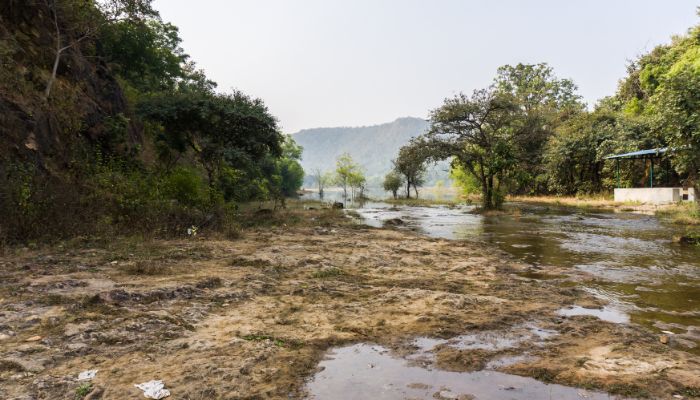
Jambughoda Wildlife Sanctuary offers a slice of wilderness that is both rich in biodiversity and steeped in history, from its past as part of the princely state of Jambughoda. This 130 sq km sanctuary, similar to the Blackbuck National Park, is a noted refuge for animals such as leopards, sloth bears, and hyenas, as well as vibrant birdlife and flora including teak, bamboo, and medicinal plant species. Visitors are captivated by the undulating hills, forest cover, and tribal hamlets dotting the valleys, all contributing to a tranquil yet exhilarating experience.
- Location: Approximately 70 km from Vadodara, Gujarat
- Famous For: Its vibrant ecosystem and recreational opportunities in a natural setting
- Recommended Visit Time: October to March, when the weather is pleasant and ideal for wildlife sightings
18. Purna Wild Life Sanctuary
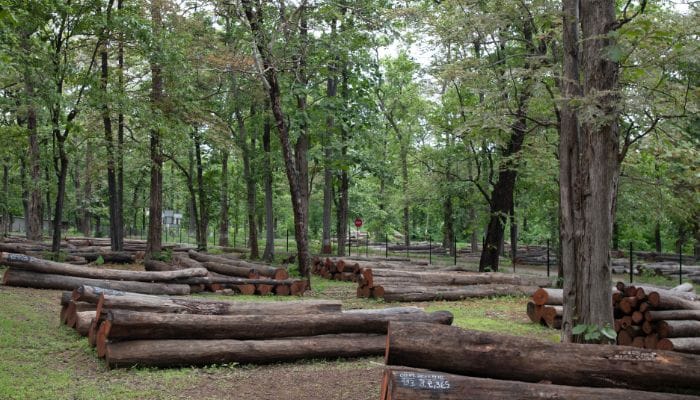
Purna Wildlife Sanctuary is a green cornerstone in Gujarat’s arena of wildlife tourism. Surrounded by dams that contribute to the lush landscape, this sanctuary is a treasure trove of biodiversity, with a tapestry of around 700 species of plants and trees. The Purna River, bolstered by the integral role of nearby dams, courses through the forest habitat providing an ideal environment for an array of wildlife, including the top predator around these parts, the leopard.
The sanctuary’s booming leopard population is further supported by water bodies created by dams, and is complemented by other wild dwellers such as the rhesus macaque, bonnet macaque, and numerous species of deer. Bird watchers too will delight in the chorus of birdcalls piercing the tranquility, inviting a deeper exploration into the thick forest cover that cozies under the highest average rainfall in the state.
- Location: 68 km from Saputara, Gujarat
- Famous For: Its thick forest cover enhanced by nearby dams, and rich mosaic of wildlife
- Recommended Visit Time: Post-monsoon for witnessing the forest in its full grandeur and experiencing cooler treks
19. Kutch Bustard Sanctuary
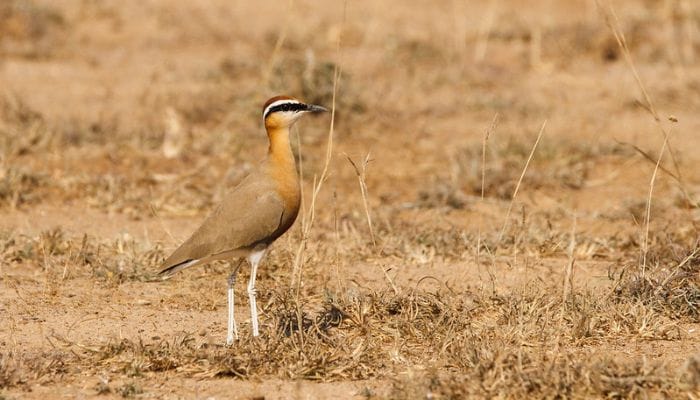 Image Source
Image SourceIn the heart of the arid landscapes of Kutch lies the Kutch Bustard Sanctuary, a critical conservation effort dedicated to the protection of the endangered Great Indian Bustard. Known also as Lala-Parjan Sanctuary, this is the smallest sanctuary in India, focused on providing a secure breeding ground for these majestic birds which are among the heaviest of flying birds globally. Birdwatchers have the unique opportunity to observe not only the Great Indian Bustard but also other avian wonders that thrive in the sanctuary’s semi-arid grasslands and marshy swamps—like the elusive lesser florican and the MacQueen’s Bustard.
Additionally, the nearby Marine National Park is a contrast with its vibrant aquatic ecosystems, brimming with marine biodiversity including sponges, an integral part of the marine fauna. It’s a place where the bustle of city life fades, replaced by the rhythmic dance of these great birds, some of which are unique to the Indian subcontinent.
- Location: Near Jakhau village in Kutch district, Gujarat
- Famous For: The endangered Great Indian Bustard and being one of the last strongholds for this species
- Recommended Visit Time: Winter months when the birds are breeding and most visible
20. Chhari Dhand Conservation Reserve
 Image Source
Image SourceThe Chhari Dhand Conservation Reserve is an ornithologist’s dream come to life, situated near the edge of the arid Banni Grasslands and the salt flats of Rann of Kutch. This seasonal desert wetland, spanning 227 square kilometers, blossoms with life, similar to the vibrant ecosystem of nearby Navsari, and is teeming with nearly 200 species of migratory birds during monsoon and winter. While Navsari does not house the same diversity of avian life, it includes the awe-inspiring Mitiyala Wildlife Sanctuary, a haven for terrestrial wildlife such as the Asiatic Lion.
Just as the Banni Grasslands are a magnet for avian biodiversity, the Marine National Park in Gujarat is equally fascinating for underwater explorers, with its rich tapestry of marine life including sponges, as well as corals and octopus. Whether visitors come to witness the spectacle of thousands of waterfowl in their element, similar to the underwater ballet of marine creatures near Jamnagar’s shore, or to document the fragile ecosystem, travelers to Chhari Dhand Conservation Reserve are guaranteed a trove of beautiful, rare sightings.
- Location: Near Fulay village, Kutch district, Gujarat
- Famous For: Hosting a diverse array of migratory birds and significant numbers of waterfowl
- Recommended Visit Time: Early mornings and evenings during monsoon and winter for the best bird observation opportunities
21. Kachchh Biosphere Reserve
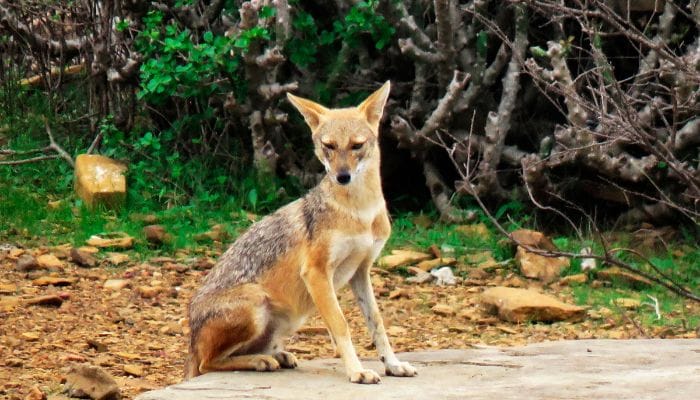
The Kachchh Biosphere Reserve is a sprawling conservation area at the heart of Gujarat’s biodiversity strategy, integrating several wildlife sanctuaries to protect its extensive ecosystems. Covering a vast 12454 square kilometers, this reserve includes the distinctive terrains of Bhuj and Kutch, acting as a sanctuary where the Indian wild ass roams free alongside a rich tapestry of wildlife including the caracal, desert fox, and various raptor species. In proximity to key locations like Gir Somnath, it is part of a larger conservation narrative across Gujarat.
Hosting habitats from dry deciduous forests, home to mahuda trees, to grasslands and wetlands, the reserve supports a spectacular biodiversity that continues to draw researchers, ecologists, and nature enthusiasts alike. It represents a significant milestone in conservation efforts, showcasing how vast landscapes can be managed to balance human needs and nature’s harmony.
- Location: Kutch District, Gujarat
- Famous For: Diverse ecosystems with unique species such as the Indian wild ass, and integration of community and conservation
- Recommended Visit Time: Winter months for a more moderate climate and enhanced wildlife visibility, ideal for spotting elusive creatures such as the sambar deer.
Reasons for Fame of Wildlife Sanctuaries and National Parks in Gujarat
| Reason for Fame | Description |
| Home to the Asiatic Lion | This place is renowned for being the last natural habitat of the Asiatic lion and a major conservation success story. |
| Large Population of Blackbucks | Known for its grassland ecosystem, it is home to a significant population of blackbucks and attracts numerous wildlife enthusiasts. |
| India’s First Marine Park | Famous for its coral reefs, diverse marine life, and mangrove forests, offering unique underwater experiences. |
| Haven for Migratory Birds | Especially popular during winter, this location is a key stopover for migratory birds and offers boat rides for bird watching. |
| Dense Forest Area with Rich Biodiversity | This region boasts a variety of wildlife including leopards and giant squirrels, set in lush, dense forests. |
| Unique Habitat for the Indian Wild Ass | Known for its distinctive population of Indian wild asses and a variety of bird species and reptiles in a unique landscape. |
| Scenic Beauty and Diverse Wildlife | Famous for its picturesque landscapes and rich wildlife, including leopards and various bird species. |
| Rich Variety of Flora and Fauna | A dense forest area that supports a wide range of species, including sloth bears and flying squirrels. |
| Conservation of Sloth Bears | This sanctuary is dedicated to protecting sloth bears and also supports other wildlife like leopards and hyenas. |
| Vast Salt Marshes and Unique Desert Wildlife | Known for its extensive salt marshes, it supports a variety of unique desert species and is the largest sanctuary in the state. |
| Teak Forests and Rich Biodiversity | Renowned for its teak forests, it is home to species like barking deer and sloth bears, contributing to rich biodiversity. |
| Rocky Terrain and Haven for Chinkara | Recognized for its rocky landscapes, it serves as a sanctuary for chinkara and various bird species, promoting nature education. |
Exploring Wildlife Sanctuaries in Gujarat: 3 Tips for an Enriching Experience
Best Time to Visit in Wildlife Sanctuaries in Gujarat
The best time to immerse yourself in Gujarat’s wildlife sanctuaries is undoubtedly during the cooler months, typically from October to March. During this period, the weather is agreeable for long excursions, and the rich biodiversity of the region comes to life, offering the most rewarding experience. Migratory birds grace the numerous bird sanctuaries with their annual visits, and the wildlife is generally more active and observable in the pleasant climate. It’s crucial to align your visit during these months to maximize the chances of witnessing the myriad of fauna and to enjoy the sanctuaries in all their glory.
Best Months to Visit Wildlife Sanctuaries and Reserves in Gujarat
| Sanctuary/Reserve | Best Months for Visit |
| Wild Ass Sanctuary | October to March |
| Nal Sarovar Birds Sanctuary | November to February |
| Jessore Sloth Bear Sanctuary | November to February |
| Barda Wildlife Sanctuary | November to February |
| Hingolgadh Nature Education Sanctuary | October to March |
| Narayan Sarovar Sanctuary | October to March |
| Khijadia Bird Sanctuary | November to February |
| Ratanmahal Sloth Bear Sanctuary | November to February |
| Kutch Desert Sanctuary | October to March |
| Gaga Wildlife Sanctuary | October to March |
| Rampara Wildlife Sanctuary | November to February |
| Thol Wildlife Sanctuary | November to March |
| Shoolpaneshwar Wildlife Sanctuary | October to March |
| Porbandar Birds Sanctuary | October to March |
| Pania Wildlife Sanctuary | November to February |
| Balaram Ambaji Wildlife Sanctuary | November to February |
| Jambughoda Wildlife Sanctuary | November to February |
| Purna Wildlife Sanctuary | November to February |
| Kutch Bustard Sanctuary | October to March |
| Chhari Dhand Conservation Reserve | October to March |
| Kachchh Biosphere Reserve | October to March |
Enhance Your Experience with Knowledgeable Guides
To truly unravel the mysteries and marvels of Gujarat’s wildlife sanctuaries, enlisting the expertise of knowledgeable guides is key. Local guides can offer invaluable insights into the behavior of the sanctuary’s residents and take you to lesser-known spots for optimal wildlife viewing. They often share anecdotal history and conservation efforts that enrich your understanding of the sanctuary’s ecosystem. Moreover, their trained eyes are apt for spotting camouflaged creatures, ensuring that you don’t miss out on those elusive wildlife moments.
Participate in Sustainable Tourism
Being a part of sustainable tourism is about cherishing Gujarat’s extraordinary wildlife while ensuring that future generations can do the same. Opt for eco-friendly lodging, engage with environmental conservation initiatives, and respect sanctuary guidelines to minimize human impact on these fragile ecosystems. Avoid littering, maintain a safe distance from wildlife, and use resources judiciously. By actively participating in sustainable practices, visitors contribute to the conservation of Gujarat’s natural heritage and support the sanctuaries’ mission of protecting India’s biodiversity.
Exploring the Cultural and Culinary Delights of Gujarat
Discover a plethora of exciting activities and attractions with our guide to the things to do in Gujarat, showcasing the state’s rich history, vibrant culture, and breathtaking landscapes.
Explore the spiritual heritage of Gujarat by visiting some of its most revered and famous temples in Gujarat, where architectural beauty and divine ambiance come together.
Immerse yourself in the rich cultural tapestry of Gujarat by experiencing the traditional attire unique to the region, detailed in this guide to the traditional dress of Gujarat, showcasing the elegance of local craftsmanship.
Celebrate the vibrant and diverse cultural heritage of Gujarat through its numerous festivals in Gujarat, which highlight the state’s rich traditions and festive spirit.
FAQs
How Many National Parks and Wildlife Sanctuaries Are There in Gujarat?
Gujarat is home to four national parks and twenty-one wildlife sanctuaries in Gujarat, each boasting its own unique ecosystem and diverse species of flora and fauna. These protected areas are crucial for wildlife conservation and offer ample opportunities for nature enthusiasts to explore the natural beauty of the state.
Can You Spot the Asiatic Lion in Any Other Place Than Gir?
The Asiatic lion can be observed in the wild only at the Gir Forest National Park in Gujarat, which serves as the last remaining bastion for this majestic species. Efforts have been made to potentially translocate lions to other reserves, but as of now, Gir remains the sole natural habitat for the Asiatic lion.
What Is the Best Time to Visit the Wildlife Sanctuaries in Gujarat?
The optimal time to visit the wildlife sanctuaries in Gujarat is between November and March. During these cooler months, the weather is comfortable for safaris, and the chance to observe diverse wildlife, including migratory birds, is significantly higher.
Are There Any Entry Fees for the National Parks and Sanctuaries?
Yes, most national parks and wildlife sanctuaries in Gujarat charge an entry fee. The cost may vary from one sanctuary to another, and additional charges may apply for services like safaris and camera usage. Visitors are advised to check the latest fee structure before planning their visit.
How does Gujarat contribute to wildlife conservation efforts in India?
Gujarat plays a key role in India’s wildlife conservation through its network of sanctuaries and national parks that safeguard diverse species and ecosystems. The state’s flagship project is the conservation of the Asiatic lion in Gir, highlighting its commitment to preserving endangered species. Gujarat’s initiatives, such as habitat protection, breeding programs, and eco-tourism, contribute significantly to the country’s biodiversity conservation goals.
Conclusion
Gujarat offers an extraordinary array of wildlife sanctuaries and national parks, each presenting a unique ecosystem and a plethora of fauna and flora. From the majestic Asiatic lions of Gir National Park to the striking variety of birds at the Nalsarovar Bird Sanctuary and the intriguing marine life in the Gulf of Kutch, Gujarat’s top wildlife sanctuaries in Gujarat are a testament to India’s rich biodiversity. These sanctuaries not only provide sanctuary to numerous species but also offer nature enthusiasts, photographers, and adventure seekers an unforgettable experience.
With tools like the WildTrails of India app at your fingertips, planning a visit to these natural wonders has never been easier. As you embark on safaris and explore these pristine environments, remember to respect and cherish the wildlife that calls it home. Gujarat’s sanctuaries are more than just tourist attractions; they are vital to conservation efforts and are a treasure to be preserved for generations to come.



Leave a reply